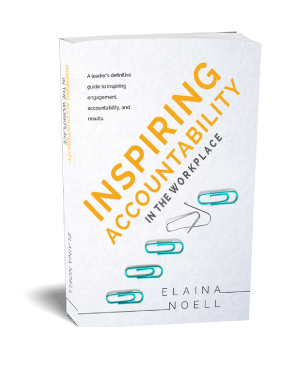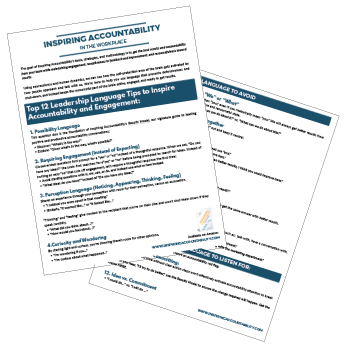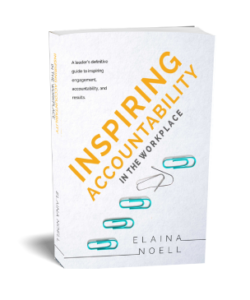What Does Accountability Mean: Compliance?

What Does Accountability Mean in the Workplace?
PART 2: COMPLIANCE
This is part of a three-part blog series on “What Does Accountability Mean in the Workplace?” Previously you learned a more productive alternative to “Taking Responsibility” and up next we’ll look at “Ownership.” But today, we’re exploring the downside of equating accountability with compliance.
Prefer to listen to this blog? You can here!
When it comes to complaints about employee accountability, I often hear statements like these:
- “He is not doing what he’s supposed to.”
- “She is not being accountable for participating in this new initiative.”
- “The executives made the decision. My team is not on board, so they’re not doing it.”
Compliance is a classic Traditional Accountability tool, resting on the weight of something equivalent to “because I said so.” While you can use your hierarchical power to demand compliance, more often than not, the disempowering context creates resentment and resistance. Leaders end up frustrated, and both sides can become passive-aggressive.
Compliance may seem like an accountability problem, but an accountability conversation is not the solution. What’s needed is a buy-in conversation.
Of course, not everyone will agree on executive decisions- we can’t expect that. But to inspire accountability, we must share new expectations in a way that minimizes resistance and maximizes receptiveness.
“While you can use your hierarchical power to demand compliance, more often than not, the disempowering context creates resentment and resistance.”
When you create directives without a conversation to support understanding and buy-in, you’re creating a team of executors, not innovators.
Disempowered executors cope by moving into malicious obedience, saying phrases like, “I just do what my manager tells me to do,” or “I didn’t think to try that because no one told me to.”
These employees are under-utilized and abdicate accountability because we can only be accountable for what we’re empowered to do.
If you’re creating executors by excluding the empowerment and respect that comes with a buy-in conversation, you’ll spend your days fruitlessly fighting for results.
Inspiring Accountability Solution to Compliance
When a decision or new methodology isn’t immediately and cheerfully adopted, here is the time to get curious about what’s in the way.
Get curious about what’s in the way of employees more eagerly and easily “complying.” You are entitled to use your hierarchical power to enforce demands, but it’s a lot more useful to include and understand those who need to execute.
Perhaps they have concerns about yet-to-be-addressed negative impacts. Perhaps they have unanswered questions on how to practically meet expectations. Maybe a little contribution context, explaining the difference this change will make and why it’s important, will help their brain prioritize it differently.
These conversations take a small amount of time compared to the significant return on results you’ll leverage moving forward. You’ll likely learn valuable aspects about what’s in the way that you can now incorporate into a way forward using the Results Model.
“We can only be accountable for what we’re empowered to do.”
How to Get Employee Buy-In:
If you feel there’s a lack of compliance, there’s likely a lack of buy-in, contribution context, or clarity. As excerpted from Inspiring Accountability in the Workplace, here are some prompts to have a productive buy-in conversation:
- Are the expectations clear enough? How will you know for sure?
- Do employees know exactly how to contribute successfully? How can they explore what behavior is needed before the moment it’s needed?
- Have you discussed: What’s in the way of successfully achieving the desired result/expectation? If you don’t know what’s in the way, it remains a hidden obstacle. Only when excuses are brought to light do they become part of navigating to the solution.
- Have you discussed: Given what’s in the way, what’s possible? We too often get stuck at what’s in the way, allowing these challenges to justify ceasing effort. The brain may not even consider how to persevere without this prompt.
- Do employees know their first action step? When we know how to start, we can begin in active effort and avoid anxious effort
- When and how will you revisit to calibrate their effort? Accountability requires revisiting. The brain’s accountability attention is only activated when the employee believes their effort will be revisited, calibrated against the desired result, and re-directed or re-designed as needed. Plus, this is how you get better results more efficiently and effectively.
Compliance Conclusion
These are all built into Inspiring Accountability’s Results Model. Adapt the Results Model to have a buy-in conversation to understand better what’s in the way of your employee buying-in, taking action, and shifting quickly from asking “what’s in the way?” to “what’s possible?”
Learn more about how to have Results Conversations in Inspiring Accountability in the Workplace, available as a paperback, eBook, and audiobook on Amazon.
Up next, let’s explore the relationship between wanting more “Ownership” and Accountability, and what to do to get the engagement and results you need. Read it now >
What do you think? Share your questions or experience in the comment section below!
Want new articles before they get published?
Subscribe!



